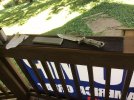- Joined
- Jul 21, 2020
- Messages
- 47
All over the internet, i see people buying knives in S30V, M390, M4...Etc
They buy them because I guess they expect better edge retention. But from what I have seen, without the propper abrasives and sharpening tools. You will get carbide tearout. Which I am starting to think that it affect the performance a lot more than what people give credit to.
Here is a video of this guy sharpening s30v in a edge pro and comparing the result to 8cr13mov
I understand that there are probably other factors going on on this result. Like for example that he is just seeing how long it cuts hair instead of how long it takes to dull.
But I think that it still shows a disappointing result under s30v which doesn't match with what other people have tested. However, all these other people like knifesteelnerds or cedric and ada have shown to use proper abrasives.
Where I am going on with all of this? I think that people should choose their knives in pair of what abrasives are you going to use to sharpen it. If you are going for something like a good ceramic stone you shouldn't go higher than cruwear(And i am not even sure of this). And if you don't want to spend in sharpening equipment maybe something that has less hard carbides would be more beneficial?
What do yu guys think?
They buy them because I guess they expect better edge retention. But from what I have seen, without the propper abrasives and sharpening tools. You will get carbide tearout. Which I am starting to think that it affect the performance a lot more than what people give credit to.
Here is a video of this guy sharpening s30v in a edge pro and comparing the result to 8cr13mov
But I think that it still shows a disappointing result under s30v which doesn't match with what other people have tested. However, all these other people like knifesteelnerds or cedric and ada have shown to use proper abrasives.
Where I am going on with all of this? I think that people should choose their knives in pair of what abrasives are you going to use to sharpen it. If you are going for something like a good ceramic stone you shouldn't go higher than cruwear(And i am not even sure of this). And if you don't want to spend in sharpening equipment maybe something that has less hard carbides would be more beneficial?
What do yu guys think?

